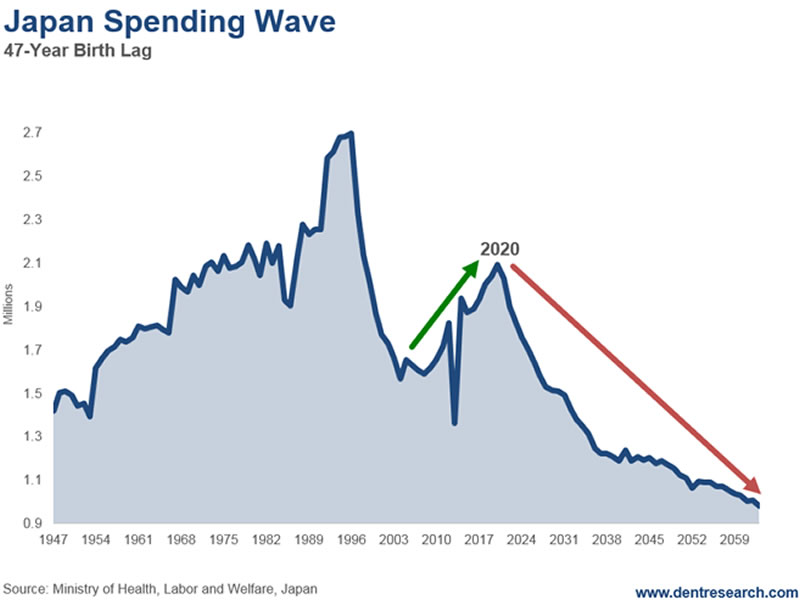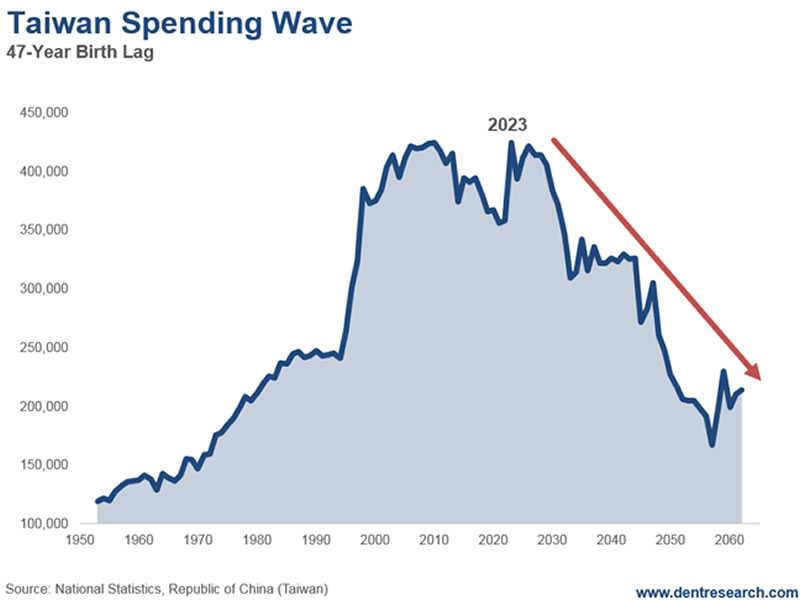Another Demographic D-Day is Coming for Japan
Economics / Japan Economy Sep 10, 2017 - 07:21 PM GMTBy: Harry_Dent

 D-Day.
D-Day.
Demographic death day.
Maybe not as bloody as the battlefield in Normandy but equally as devastating in the long term.
And Japan is facing its second one.
Japan’s Baby Boom started to slow down in 1942 coming into World War II and peaked – forever – in 1949 after soldiers came home from war and made a lot of babies.
It was the first major developed country to peak on a 47-year lag for spending in its economy. The effects of that first drop-off in births during WWII hit the country after 1989. The second, bigger hit arrived in 1997, and it has felt the negative effects ever since. Look at Japan’s Spending Wave below…

Japan has been in an endless slowdown with ever-escalating QE ever since 1997.
Even when its millennial generation turned up mildly around 2003, and its stock market bottomed down 80%, it has only seen a rise back to 21,000 recently. That’s nowhere near its 39,000 peak in late 1989 (a peak we forecast, I’ll add, when we saw the first Demographic D-Day coming and warned of its massive stock and real estate bubbles bursting).
Well, Japan has a second D-Day coming after 2020, right after we likely endure a global market and economic collapse in the next two or three years.
Make no mistake about it: Japan is dying and its demographic decline will only get much worse again after 2020. So, any reprieve in its economy from endless stimulus and super-low interest rates will be short-lived.
Germany is the next to collapse demographically in Europe following Greece, Portugal, and Italy. Spain comes last, but with an equally bitter decline after 2025.
South Korea peaks the last for the East Asia “Tigers” in 2018.
When I lecture in South Korea, my summary statement is that “you are Japan on a 22-year lag.” That’s the difference between their Baby Boom peaks – 1949 and 1971.
Taiwan, in the chart below, also has already peaked and will see downtrends in consumer spending for decades. This started in 2008 already, but will accelerate after 2023.

The greater part of the developed world has peaked: Japan in late 1996, the U.S. in late 2007, most of Europe in late 2011… and now the rest of East Asia and Japan’s final demographic D-Day.
This is demographic destiny: The greatest global boom in history turns into the greatest bust. Yes! There are cycles in everything. Affluent, urban households have less kids and that reverses the very boom that they created.
If central bankers think they can offset these increasing demographic declines and unprecedented debt levels with “something for nothing” free money – they’re in for a nasty surprise!
Harry
Follow me on Twitter @HarryDentjr
Harry studied economics in college in the ’70s, but found it vague and inconclusive. He became so disillusioned by the state of the profession that he turned his back on it. Instead, he threw himself into the burgeoning New Science of Finance, which married economic research and market research and encompassed identifying and studying demographic trends, business cycles, consumers’ purchasing power and many, many other trends that empowered him to forecast economic and market changes.
Copyright © 2017 Harry Dent- All Rights Reserved Disclaimer: The above is a matter of opinion provided for general information purposes only and is not intended as investment advice. Information and analysis above are derived from sources and utilising methods believed to be reliable, but we cannot accept responsibility for any losses you may incur as a result of this analysis. Individuals should consult with their personal financial advisors.
© 2005-2022 http://www.MarketOracle.co.uk - The Market Oracle is a FREE Daily Financial Markets Analysis & Forecasting online publication.


